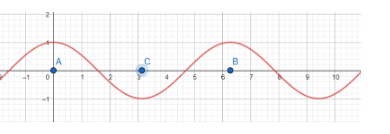Question
Question: Prove that \({{\cos }^{-1}}\left( \dfrac{1}{x} \right)={{\sec }^{-1}}x,x\in \left( -\infty ,-1 \righ...
Prove that cos−1(x1)=sec−1x,x∈(−∞,−1]⋃[1,∞)
Solution
Hint: Use the fact that if y=cos−1x, then x=cosy. Assume y=cos−1(x1). Use the previously mentioned fact and write x in terms of y. Take sec−1 on both side and use the fact that if y\in \left[ 0,\pi \right]-\left\\{ \dfrac{\pi }{2} \right\\}, then sec−1(secy)=y and hence prove the result.
Complete step-by-step answer:
Before dwelling into the proof of the above question, we must understand how cos−1x is defined even when cosx is not one-one.
We know that cosx is a periodic function.
Let us draw the graph of cosx

As is evident from the graph cosx is a repeated chunk of the graph of cosx within the interval [A,B] , and it attains all its possible values in the interval [A,C]. Here A=0,B=2π and C=π
Hence if we consider cosx in the interval [A, C], we will lose no value attained by cosx, and at the same time, cosx will be one-one and onto.
Hence cos−1x is defined over the domain [−1,1], with codomain [0,π] as in the domain [0,π], cosx is one-one and Rcosx=[−1,1].
Now since arccosx is the inverse of cosx it satisfies the fact that if y=arccosx, then cosy=x.
So let y=cos−1(x1), y\in \left[ 0,\pi \right]-\left\\{ \dfrac{\pi }{2} \right\\} as x1=0
Hence we have cosy=x1
Hence we have x=cosy1=secy
Taking sec−1 on both sides, we get
sec−1x=sec−1(secy)
Now since y\in \left[ 0,\pi \right]-\left\\{ \dfrac{\pi }{2} \right\\} and we know that if y\in \left[ 0,\pi \right]-\left\\{ \dfrac{\pi }{2} \right\\}, then sec−1(secy)=y [Valid only in principal branch]
Hence we have
sec−1x=y⇒y=sec−1y
Reverting to the original variable, we get
cos−1(x1)=sec−1(x)
Since x1 is in the domain of cos−1x, we get
x1∈[−1,1]⇒x∈(−∞,−1]⋃[1,∞)
Hence we have cos−1(x1)=sec−1x,x∈(−∞,−1]⋃[1,∞)
Note: [1] The above-specified codomain for cos−1x is called principal branch forcos−1x . We can select any branch as long as cosx is one-one and onto and Range =[−1,1]. Like instead of [0,π], we can select the interval [π,2π]. The proof will remain the same as above.
